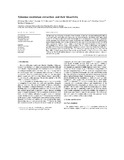Tylosema esculentum extractives and their bioactivity

View/
Date
2011Author
Mazimba, O.
Majinda, R.R.
Modibedi, C.
Masesane, I.B.
Cencicˇ, A.
Chingwaru, W.
Publisher
Elsevier Science Ltd, http://www.elsevier.com/locate/bmcType
Published ArticleMetadata
Show full item recordAbstract
The investigation of Tylosema esculentum (Morama) husks, cotyledons, and tuber yielded griffonilide 2,
compound 1, griffonin 3, gallic acid 4, protocatechuic acid 5, b-sitosterol 6, behenic acid 7, oleic acid 8,
sucrose 9, 2-O-ethyl-a-D-glucopyranoside 10, kaempferol 11 and kaempferol-3-O-b-D-glucopyranoside
12. The structures of the isolates were determined by NMR, HR-TOF EIMS, IR and UV–vis spectroscopy,
and by comparison with literature data. The husk EtOAc and n-butanol extracts demonstrated >90% DPPH radical scavenging activity at concentrations of 25, 50 and 250 lg/mL. Furthermore the husk extracts
showed higher total phenolic content (233 mg GAE/g). The extractives exhibited minimum inhibitory
quantities of 50–100 lg or no activity against Staphylococcus aureus, Escherichia coli, Bacillus subtilis, Pseudomonas
aeruginosa and Candida albicans. The tuber extracts were inactive against Caco-2 and Hela cell lines, while the husk extracts showed low activity against Caco-2 and Vero cell line with IC50 values >400 lg/mL. The GC–MS analysis showed the beans and tuber non-polar (n-hexane) extracts major constituents
as fatty acids.
